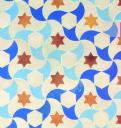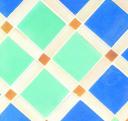Fátima Quesada’s Art of the ‘Little Stones’
 Fátima Quesada was scarcely out of school when she left her hometown Madrid to search for artistic inspiration among the bewitching monuments of old Granada. Thrilled by the ancient mosaics of the Alhambra, she developed a fascination for the mysteries of ceramics and promptly enrolled in classes. The next year was spent learning the basics, such as the physical and chemical characteristics of clay, production and colouring techniques, and artistic design. It was a formative year, marked most of all by her personal discovery of ceramic art, for it was when she moved to the Alpujarras that Fátima’s training commenced in earnest. “I was really fortunate to come into contact with so many outstanding experts—in the Alpujarras of all places. From Japanese master craftsmen to former NASA scientists probing the possible applications of clay ceramic products, I learnt more from watching them, talking and working in teaching courses with them than I did from official courses.”
Fátima Quesada was scarcely out of school when she left her hometown Madrid to search for artistic inspiration among the bewitching monuments of old Granada. Thrilled by the ancient mosaics of the Alhambra, she developed a fascination for the mysteries of ceramics and promptly enrolled in classes. The next year was spent learning the basics, such as the physical and chemical characteristics of clay, production and colouring techniques, and artistic design. It was a formative year, marked most of all by her personal discovery of ceramic art, for it was when she moved to the Alpujarras that Fátima’s training commenced in earnest. “I was really fortunate to come into contact with so many outstanding experts—in the Alpujarras of all places. From Japanese master craftsmen to former NASA scientists probing the possible applications of clay ceramic products, I learnt more from watching them, talking and working in teaching courses with them than I did from official courses.”
 Another turning point in Fátima’s career came when she met Donald Grey. This Canadian architect, who enjoys virtual cult status among artists, artisans and architects alike, was involved in the revival of traditional Andalusian crafts and techniques; his tireless research unearthed a lot of the knowledge that had gradually been lost since the 19th century. Keen to bring these old crafts back to life, he gathered a group of talented artisans around him and established a workshop in Lebrija (Sevilla), where stonemasons, carpenters, gardeners, plasterers, bricklayers, blacksmiths and ceramicists trained in the old Hispano-Muslim techniques. “Donald has made an immeasurable contribution to the preservation of this part of Andalucía’s cultural and artistic heritage. Through him we became acquainted with ancient wisdom, such as the laws governing proportion, aesthetics and harmony in art and architecture.” It was at this point that Fátima decided to specialise in Hispano-Muslim azulejos (decorative tiles and mosaics). Although pictorial scenes are unusual in Muslim art, the geometric patterns used instead provide a wealth of decorative options, yet they are more than purely decorative—the complex equations that underlie them encapsulate the Muslim understanding of the universe. “Add combinations of colours and you create a geometry within the greater geometry. The visual effect of this is almost three-dimensional.”
Another turning point in Fátima’s career came when she met Donald Grey. This Canadian architect, who enjoys virtual cult status among artists, artisans and architects alike, was involved in the revival of traditional Andalusian crafts and techniques; his tireless research unearthed a lot of the knowledge that had gradually been lost since the 19th century. Keen to bring these old crafts back to life, he gathered a group of talented artisans around him and established a workshop in Lebrija (Sevilla), where stonemasons, carpenters, gardeners, plasterers, bricklayers, blacksmiths and ceramicists trained in the old Hispano-Muslim techniques. “Donald has made an immeasurable contribution to the preservation of this part of Andalucía’s cultural and artistic heritage. Through him we became acquainted with ancient wisdom, such as the laws governing proportion, aesthetics and harmony in art and architecture.” It was at this point that Fátima decided to specialise in Hispano-Muslim azulejos (decorative tiles and mosaics). Although pictorial scenes are unusual in Muslim art, the geometric patterns used instead provide a wealth of decorative options, yet they are more than purely decorative—the complex equations that underlie them encapsulate the Muslim understanding of the universe. “Add combinations of colours and you create a geometry within the greater geometry. The visual effect of this is almost three-dimensional.”
Above all, however, Fátima’s tiles add beauty and elegance to just about every part of a home. Working to her clients’ requirements, she never produces the exact same design twice. “I achieve the quality of the old Moorish tiles because I use the same manual techniques. If you try to do so with modern production methods you end up with a bad copy.” Bringing past and present together, Fátima has revived the true art of the ‘little stones’.










